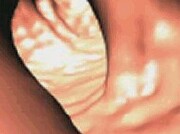- Skip Storing This Everyday Product in the Fridge Door
- Green Tea + B3 Pairing May Boost Brain Health
- Navigating Your Midlife Crisis: Embracing New Possibilities
- City Raccoons Showing Signs of Domestication
- Mapping the Exposome: Science Broadens Focus to Environmental Disease Triggers
- One Week Less on Social Media Linked to Better Mental Health
- Your Brain Changes in Stages as You Age, Study Finds
- Some Suicide Victims Show No Typical Warning Signs, Study Finds
- ByHeart Formula Faces Lawsuits After Babies Sickened With Botulism
- Switch to Vegan Diet Could Cut Your Greenhouse Gas Emissions in Half
Sigmoidoscopy Does Cut Risk of Dying From Colon Cancer: Study

Colon cancer screening done by sigmoidoscopy — a less invasive, cheaper alternative to colonoscopy — does cut people’s risk of developing or dying from the disease, a new clinical trial finds.
Experts said the study, conducted in Norway and reported in the Aug. 13 issue of the Journal of the American Medical Association, confirms the value of sigmoidoscopy screening.
But in the United States, where few doctors even perform sigmoidoscopy, the results are unlikely to make a difference in everyday practice.
“Sigmoidoscopy is definitely second-best to colonoscopy,” said Dr. James Church, a colorectal surgeon at the Cleveland Clinic in Ohio.
That’s mainly because sigmoidoscopy looks only at the lower portion — or “left side” — of the colon, said Church, who was not involved in the study. Colonoscopy gives doctors a view of the entire colon.
Both procedures not only detect cancer but also help prevent it — by allowing doctors to remove potentially precancerous growths called polyps. But colonoscopy can pick up polyps throughout the colon.
“Colonoscopy is not perfect, by any means,” Church said. But, he added, “if you don’t want to get colon cancer, colonoscopy is the best option.”
The new trial was conducted in Norway, where there is no routine colon cancer screening, explained lead researcher Dr. Oyvind Holme, of Sorlandet Hospital in Kristiansand, Norway.
That allowed the researchers to offer one-time sigmoidoscopy screening to over 20,000 50- to 64-year-old adults, then compare them with 78,000 people the same age who were not offered any kind of colon cancer screening.
Half of the sigmoidoscopy group also received a stool test to look for hidden blood — another option for colon cancer screening.
Holme’s team found that people who underwent screening were 27 percent less likely to die of colon cancer over the next decade, versus the unscreened group.
According to Holme, the findings bolster evidence that sigmoidoscopy is a “valuable tool” for colon cancer screening.
But, he said, they don’t mean that sigmoidoscopy is the best tool. “We did not compare flexible sigmoidoscopy to other screening methods,” Holme pointed out.
In the United States, experts advise most people to begin colon cancer screening at age 50.
The U.S. Preventive Services Task Force recommends three choices: an annual stool test; sigmoidoscopy every five years, along with stool testing every three years; or colonoscopy every 10 years.
In practice, though, colonoscopy is by far the most common test in the United States.
Sigmoidoscopy does have a number of advantages over colonoscopy, Holme said. The pre-exam bowel cleanse is easier to take, and the procedure itself is faster, does not require sedation and can be done by a primary care doctor or trained nurse — whereas colonoscopies are done by gastroenterologists.
Sigmoidoscopy is also much cheaper: In the United States, it costs about $150 to $300, versus $1,000 or more for a colonoscopy.
But some of those advantages are not as good as they sound, according to Church. Since patients are not sedated for sigmoidoscopy, he said, it’s actually more uncomfortable than colonoscopy, for example.
What this study shows, Church said, is that sigmoidoscopy is better than no screening — for preventing cancers on the left side of the colon.
Among patients who were screened, there were 113 cancers per 100,000 people each year of the study. That compared with 141 per 100,000 in the unscreened group. But the difference was mostly seen in cancers in the left side of the colon.
“For right-sided colon cancer, sigmoidoscopy is, statistically, the same as doing nothing,” Church said.
In the end, questions over how sigmoidoscopy fits into colon cancer screening could actually be moot in the near future, according to an editorial published with the study.
New DNA stool tests, which are much more precise than standard stool tests, have the potential to reduce routine colonoscopies, writes Dr. Allan Brett, of the University of South Carolina School of Medicine in Columbia.
“Fecal DNA tests could change the way we think about stool testing,” Church said. “They’re so much better than what we have now.”
Just yesterday, the U.S. Food and Drug Administration approved a DNA-based stool test that detects colon cancer with more than 90 percent accuracy. Still, experts said, the test is not intended to replace colonoscopies — and any positive result would have to be followed up with a colonoscopy to confirm the diagnosis.
The hope is that new and better options will encourage more people to get screened. A recent government study found that one-third of Americans eligible for colon cancer screening aren’t doing it.
More information
The American Cancer Society has more on colon cancer screening.
Source: HealthDay
Copyright © 2025 HealthDay. All rights reserved.










